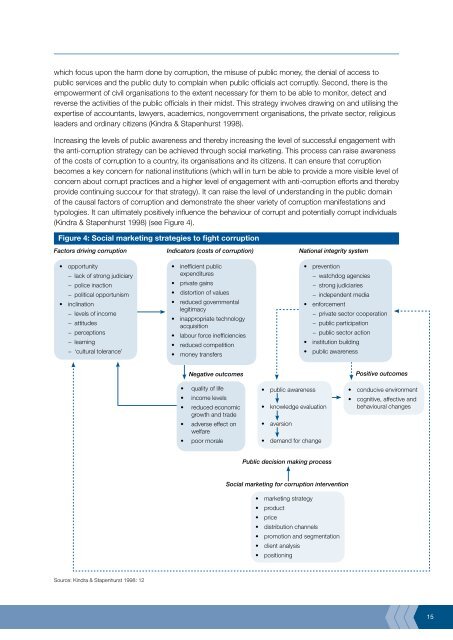Review of anti-corruption strategies Rob McCusker - Australian ...
Review of anti-corruption strategies Rob McCusker - Australian ...
Review of anti-corruption strategies Rob McCusker - Australian ...
Create successful ePaper yourself
Turn your PDF publications into a flip-book with our unique Google optimized e-Paper software.
which focus upon the harm done by <strong>corruption</strong>, the misuse <strong>of</strong> public money, the denial <strong>of</strong> access to<br />
public services and the public duty to complain when public <strong>of</strong>ficials act corruptly. Second, there is the<br />
empowerment <strong>of</strong> civil organisations to the extent necessary for them to be able to monitor, detect and<br />
reverse the activities <strong>of</strong> the public <strong>of</strong>ficials in their midst. This strategy involves drawing on and utilising the<br />
expertise <strong>of</strong> accountants, lawyers, academics, nongovernment organisations, the private sector, religious<br />
leaders and ordinary citizens (Kindra & Stapenhurst 1998).<br />
Increasing the levels <strong>of</strong> public awareness and thereby increasing the level <strong>of</strong> successful engagement with<br />
the <strong>anti</strong>-<strong>corruption</strong> strategy can be achieved through social marketing. This process can raise awareness<br />
<strong>of</strong> the costs <strong>of</strong> <strong>corruption</strong> to a country, its organisations and its citizens. It can ensure that <strong>corruption</strong><br />
becomes a key concern for national institutions (which will in turn be able to provide a more visible level <strong>of</strong><br />
concern about corrupt practices and a higher level <strong>of</strong> engagement with <strong>anti</strong>-<strong>corruption</strong> efforts and thereby<br />
provide continuing succour for that strategy). It can raise the level <strong>of</strong> understanding in the public domain<br />
<strong>of</strong> the causal factors <strong>of</strong> <strong>corruption</strong> and demonstrate the sheer variety <strong>of</strong> <strong>corruption</strong> manifestations and<br />
typologies. It can ultimately positively influence the behaviour <strong>of</strong> corrupt and potentially corrupt individuals<br />
(Kindra & Stapenhurst 1998) (see Figure 4).<br />
Figure 4: Social marketing <strong>strategies</strong> to fight <strong>corruption</strong><br />
Factors driving <strong>corruption</strong> Indicators (costs <strong>of</strong> <strong>corruption</strong>) National integrity system<br />
•<br />
•<br />
opportunity<br />
− lack <strong>of</strong> strong judiciary<br />
− police inaction<br />
− political opportunism<br />
inclination<br />
− levels <strong>of</strong> income<br />
− attitudes<br />
− perceptions<br />
− learning<br />
− ‘cultural tolerance’<br />
Source: Kindra & Stapenhurst 1998: 12<br />
•<br />
•<br />
•<br />
•<br />
•<br />
•<br />
•<br />
•<br />
inefficient public<br />
expenditures<br />
private gains<br />
distortion <strong>of</strong> values<br />
reduced governmental<br />
legitimacy<br />
inappropriate technology<br />
acquisition<br />
labour force inefficiencies<br />
reduced competition<br />
money transfers<br />
•<br />
•<br />
•<br />
•<br />
•<br />
Negative outcomes<br />
quality <strong>of</strong> life<br />
income levels<br />
reduced economic<br />
growth and trade<br />
adverse effect on<br />
welfare<br />
poor morale<br />
•<br />
•<br />
•<br />
•<br />
prevention<br />
− watchdog agencies<br />
− strong judiciaries<br />
− independent media<br />
enforcement<br />
Public decision making process<br />
− private sector cooperation<br />
− public participation<br />
− public sector action<br />
institution building<br />
public awareness<br />
Social marketing for <strong>corruption</strong> intervention<br />
•<br />
•<br />
•<br />
•<br />
•<br />
•<br />
•<br />
•<br />
•<br />
•<br />
•<br />
public awareness<br />
knowledge evaluation<br />
aversion<br />
demand for change<br />
marketing strategy<br />
product<br />
price<br />
distribution channels<br />
promotion and segmentation<br />
client analysis<br />
positioning<br />
•<br />
•<br />
Positive outcomes<br />
conducive environment<br />
cognitive, affective and<br />
behavioural changes















